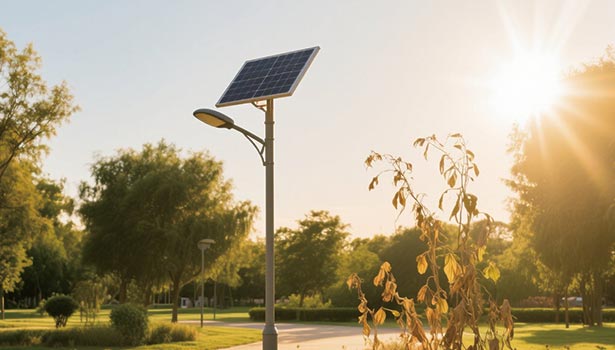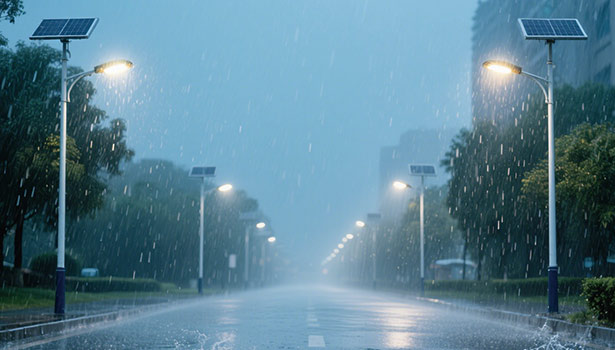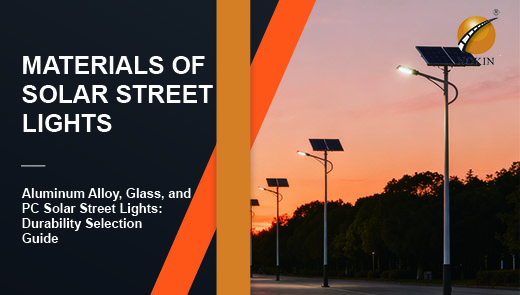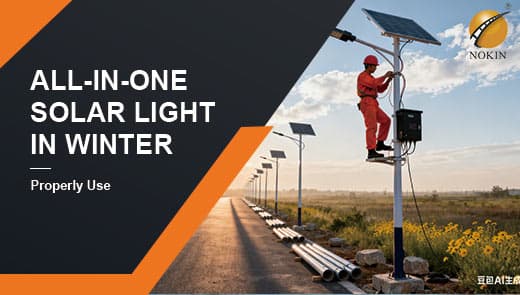Solar Street Light in Summer: Challenges and Maintenance Guide
As summer temperatures in the northern hemisphere climb to 30°C+, ample sunshine provides ideal power generation conditions for solar street lights, but sustained high temperatures (battery efficiency drops by 3%-5% in areas with daily average temperatures exceeding 28°C), sudden thunderstorms (an average of 15-20 lightning events per square kilometer per year) and frequent typhoons (risk of wind speed exceeding level 12 in coastal areas) are becoming major threats to street light systems. As the core infrastructure of urban green lighting, summer maintenance of solar street lights requires systematic solutions. Next, NOKIN will introduce you to practical maintenance tips and coping strategies in detail around the challenges faced by solar street lights in summer. Whether you are responsible for municipal lighting projects or rural lighting projects, these proven practical tips can help your system maintain optimal performance in the hot summer.

High Temperatures in Summer Impact Solar Street Light Components
Solar Panel Overheating Problem
In the hot summer, the intensity of solar radiation is high, and solar panels are exposed to high temperature environments for a long time, which is very easy to overheat. From a professional point of view, solar panels have a key indicator of temperature coefficient, which directly reflects the impact of temperature changes on the efficiency of solar panels. For example, if a panel has a temperature coefficient of -0.25%/°C, the efficiency of the panel will decrease by 4.5% when the ambient temperature rises from the standard test temperature of 25°C to 38°C. Although this efficiency loss does not pose a fatal threat to sustainability, long-term exposure to high temperatures will accelerate the aging of the panels, significantly shorten their service life, and reduce the duration and brightness of nighttime lighting.
Impact on LED Lamp Electronic Components
LED lamps can show good energy efficiency in low temperature environments, but high temperatures will have a negative impact on their performance. The luminous quality and service life of LED lamps are closely related to temperature, and the heat inside them is mainly generated in the diode part. Whether the heat can be effectively dissipated depends on many factors, including the design of the heat sink, the installation method of the lamp, and whether it is equipped with a housing. Although LED lamps can work normally in high temperature environments, their optimal operating temperature is about 25°C, but long-term exposure to high temperature environments will still have a certain impact on their performance. However, compared with traditional incandescent bulbs, LED lamps generate less heat, and their surface temperature is on average 50% lower than other lamps, and under normal circumstances, they will not cause burns when touched.
Impact on the Performance of Batteries
The energy storage batteries of solar street lights (such as lead-acid batteries and lithium-ion batteries) will face severe tests in high temperature environments. The chemical reaction rate inside the battery is closely related to the temperature. When the ambient temperature exceeds 25℃, the self-discharge rate of the battery will double for every 10℃ increase in temperature. Taking lead-acid batteries as an example, their capacity will decay significantly with increasing temperature - studies have shown that when the temperature exceeds 25℃, the battery capacity will decrease by about 1% for every 1℃ increase. This decay is irreversible, and long-term high temperature will cause the effective capacity of the battery to decrease rapidly, thereby shortening the nighttime lighting time of solar street lights.
In order to reduce the impact of high temperature on batteries, high-temperature resistant batteries should be given priority in the design stage of street lights, and the installation position of the batteries should be optimized - for example, the integrated design of "battery built in the lamp head" should be adopted to hide the battery in a dark place inside the lamp to avoid direct sunlight. At the same time, ensure that the battery compartment has a good ventilation and heat dissipation structure. If necessary, a small cooling fan or thermal conductive silica gel can be installed to control the battery operating temperature within the ideal range of 20℃-30℃.
Challenges of Extreme Weather in Summer to Solar Street Lights
The Impact of Strong Winds and Heavy Rains
Summer is a high-incidence season for strong winds and heavy rains, especially in coastal areas, where typhoons frequently strike. Strong winds acting on street light poles and lamp heads will generate huge forces, causing the poles to tilt, the lamps to loosen, or even collapse. At the same time, heavy rains may cause water to enter the street light batteries, affecting the battery's charging and discharging performance, thereby reducing the working efficiency of the street lights. If not handled in time, it may also cause serious faults such as short circuits, which will not only affect lighting, but also bring safety hazards.
Threat of Lightning
Lightning weather is another major threat to solar street lights in summer. The instantaneous high voltage and strong current generated by lightning may break down the electrical components of street lights and damage key components such as solar controllers, batteries, and LED lamps. Therefore, when purchasing solar street lights, it is crucial to equip them with a complete lightning protection device, which can effectively introduce lightning current into the earth and protect the safety of the street light system.
Challenges of Summer Environmental Factors
In summer, plants grow vigorously, and green belts and trees are lush with branches and leaves. However, this is not all good for solar street lights. If the branches and leaves of plants around the street lights block the solar panels, it will hinder sunlight, reduce the energy absorption of the panels, and lead to insufficient battery energy storage. The street lights cannot light up normally at night or the lighting time is shortened. Therefore, timely trimming of branches around the street lights and keeping the surface of the panels unobstructed are important measures to ensure the normal operation of the street lights.

Maintenance Tips for Solar Street Lights in Summer
Select High Temperature Resistant Solar Street Lights
When purchasing solar street lights, products with high temperature tolerance should be given priority. Pay attention to the temperature coefficient of solar panels and try to choose products with lower temperature coefficients, such as panels with a temperature coefficient of less than -0.5%/℃, which can maintain good power generation efficiency in high temperature environments. In addition, solar street lights using new materials and advanced manufacturing processes usually have better high temperature resistance and anti-aging performance. Although the initial purchase cost may be high, it is more cost-effective in terms of long-term use and maintenance costs.
Choose Solar Street lights with Adjustable Panels
Solar street lights with adjustable panels have significant advantages. By manually or automatically adjusting the angle of the solar panel to keep it at the best angle with the sun's rays, the efficiency of light absorption can be improved. When the midday sun is too strong, the angle can be adjusted appropriately to reduce direct exposure and avoid overheating of the solar panel.
Install a Cooling Device
Installing a cooling device is an effective way to deal with the problem of overheating of the solar panel. Active cooling systems, such as fan cooling and liquid cooling, can actively remove heat from the surface of the solar panel and maintain it within the optimal operating temperature range. The fan cooling system accelerates air circulation and reduces the temperature of the solar panel by installing a cooling fan; liquid cooling uses circulating coolant to absorb the heat of the solar panel and dissipate it to the external environment, and the cooling effect is more significant. However, the liquid cooling system has a complex structure and high installation and maintenance costs, so it needs to be selected according to actual needs.
Use a Protective Coating
Applying a protective coating on the surface of the solar panel can effectively resist UV damage and reduce heat absorption. The protective coating has a reflective function, which can reflect part of the UV and heat, reduce the surface temperature of the solar panel, and protect the packaging materials and circuits of the solar panel, slow down the aging rate, and extend the service life of the solar panel. There are many kinds of protective coatings available on the market. Products with good weather resistance and adhesion should be selected and applied according to the correct construction process.
Regular Inspection and Cleaning
Regular inspection and cleaning are the basic work of daily maintenance of solar street lights. At least once a week, the appearance of the street lights should be inspected to see whether the lamp poles are vertical, whether the lamps are loose, whether the panels are cracked or damaged, etc. At the same time, use soft cleaning tools such as sponges and special cleaning agents to remove dust, leaves, bird droppings and other stains on the surface of the panels to ensure that the surface of the panels is clean and improve the light absorption efficiency. Avoid using hard tools when cleaning to prevent scratching the surface of the panels.
Battery Maintenance
The battery is an important energy storage component of solar street lights, and its performance directly affects the lighting effect of street lights. In the high temperature environment in summer, the chemical activity of the battery is enhanced, the self-discharge rate is accelerated, and the capacity will gradually decrease. Therefore, the battery capacity should be tested once a month, and when the battery capacity drops below 80% of the rated capacity, it should be replaced in time. In addition, choose street lights with good insulation and ventilation design, install the battery in a relatively stable temperature position, and avoid direct sunlight. For lead-acid batteries, it is also necessary to regularly check the electrolyte level and replenish distilled water in time to ensure the normal operation of the battery.
Circuit and Waterproof Inspection
Regular inspection of the circuit system of solar street lights is crucial. Open the inspection door at the bottom of the street light to check whether the connection line of the solar controller is firm, whether it is loose, oxidized or in poor contact; check whether the waterproof tape of each joint has fallen off, and whether there are signs of water seepage. If problems are found, the connection points should be tightened in time and the waterproof tape should be replaced to prevent water vapor from entering the circuit and causing short circuit failure. After the rainstorm, the circuit inspection should be strengthened to ensure the safety and reliability of the street light system.
Countermeasures for solar street lights in special circumstances
Preparation before Strong Winds and Rainstorms
Before the arrival of strong winds and rainstorms, a comprehensive safety inspection of solar street lights is required. Check whether the foundation of the light pole is firm and whether the anchor bolts are loose; check whether the fixing brackets of the lamps and panels are firm and whether there are any deformation or damage; check whether the lightning protection device is connected normally. For street lamps with potential safety hazards, they should be reinforced and repaired in time. If necessary, they can be temporarily turned off to avoid accidents in bad weather. In addition, debris around the street lamps should be cleaned up to prevent strong winds from blowing debris onto the street lamps and causing damage.
Maintenance after Heavy Rain
After heavy rain, solar street lamps should be inspected and repaired in time. Check whether the street lamps are damaged by water immersion, and check whether there are water stains in the battery box. If water is found, the battery should be taken out immediately, wiped with a dry cloth, and dried. Check whether the lamp pole is tilted or shifted, and recalibrate and fix it if necessary. At the same time, check the circuit system again to ensure that there is no short circuit or leakage. After confirming that everything is normal, the street lamp can be turned on again.

Summary
Summer solar street light maintenance is the core link to ensure its efficient operation, covering three key dimensions: product selection, daily maintenance, and extreme weather response. Scientific maintenance can not only extend the service life of street lights by 30%-50%, but also save more than 40% of operation and maintenance costs by reducing the frequency of replacement, helping urban and rural lighting systems achieve long-term and stable green energy-saving goals. As an important part of the smart lighting solution, the summer maintenance of solar street lights needs to be combined with regional climate characteristics (such as high temperature and high humidity coastal areas, and plateau areas with strong ultraviolet rays) to formulate differentiated plans.




